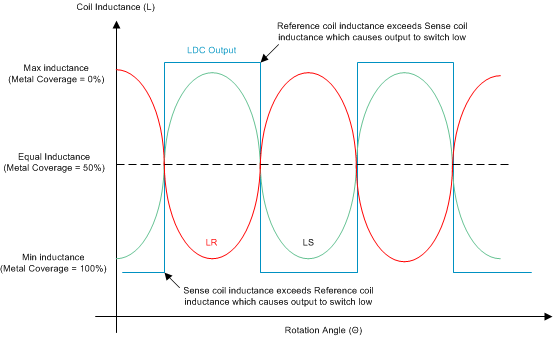SNOAA90A february 2023 – may 2023 DRV5033-Q1 , LDC3114-Q1 , TMAG5170-Q1 , TMAG5170D-Q1 , TMAG5173-Q1
3.4 Encoder Using Inductive
Inductive based encoders are similar to Hall-effect sensing but the encoders use any conductive metal as the target and are immune to DC magnetic fields. These sensors can often use a metal that is already present in a mechanical design such as the teeth of a rotating gear to give an incremental output. One example of an inductive encoder is the Inductive Sensing 32-Position Encoder Knob Reference Design using the LDC0851. This reference design uses a metal target in a PCB that is attached to the knob. As the metal crosses over the inductive sensing coils, the inductance increases and decreases in a cyclical pattern. The LDC0851 does a comparison between the sensor and reference coils to determine whether the digital output must be high or low.
 Figure 3-6 LDC0851 Encoder Inductance Change and Digital Output
Figure 3-6 LDC0851 Encoder Inductance Change and Digital OutputIf the designer places the sensors correctly, the design can achieve a quadrature output and increase the number of positions detected by each passing metal target.

Figure 3-7 Reference Coil Placement and Inductance Shifts
As seen in Figure 3-7, there are eight positions per rotation for a two-target design. Implementing an inductive encoder this way provides a robust design that is immune to dirt, grease, and external DC magnetic fields but designers must consider the limitations of this approach. The size of the inductive sensor is an important factor to keep in mind. The distance between the metal target and inductive sensor coil is a direct relationship to the coil diameter, therefore the target distance must decrease whenever the coil size decreases. While implementing small coils is possible, there must be enough space to layout a PCB coil under the metal target. Layout techniques like those used in the LDC1312 Incremental Encoder Knob, reference guide can be used to implement smaller coils, but difficult can still exist when designing a high positions per rotation encoder in a small space.